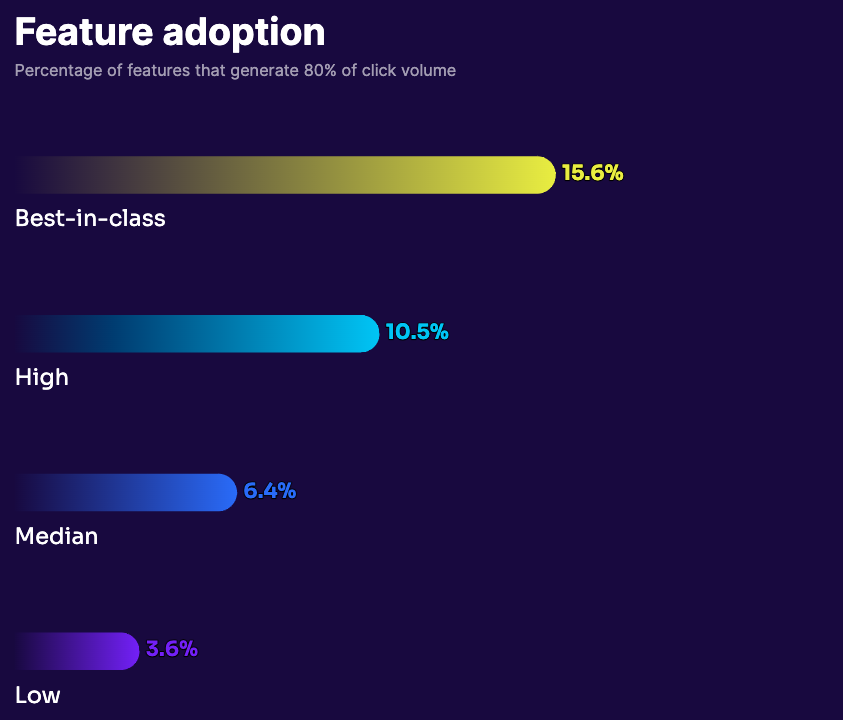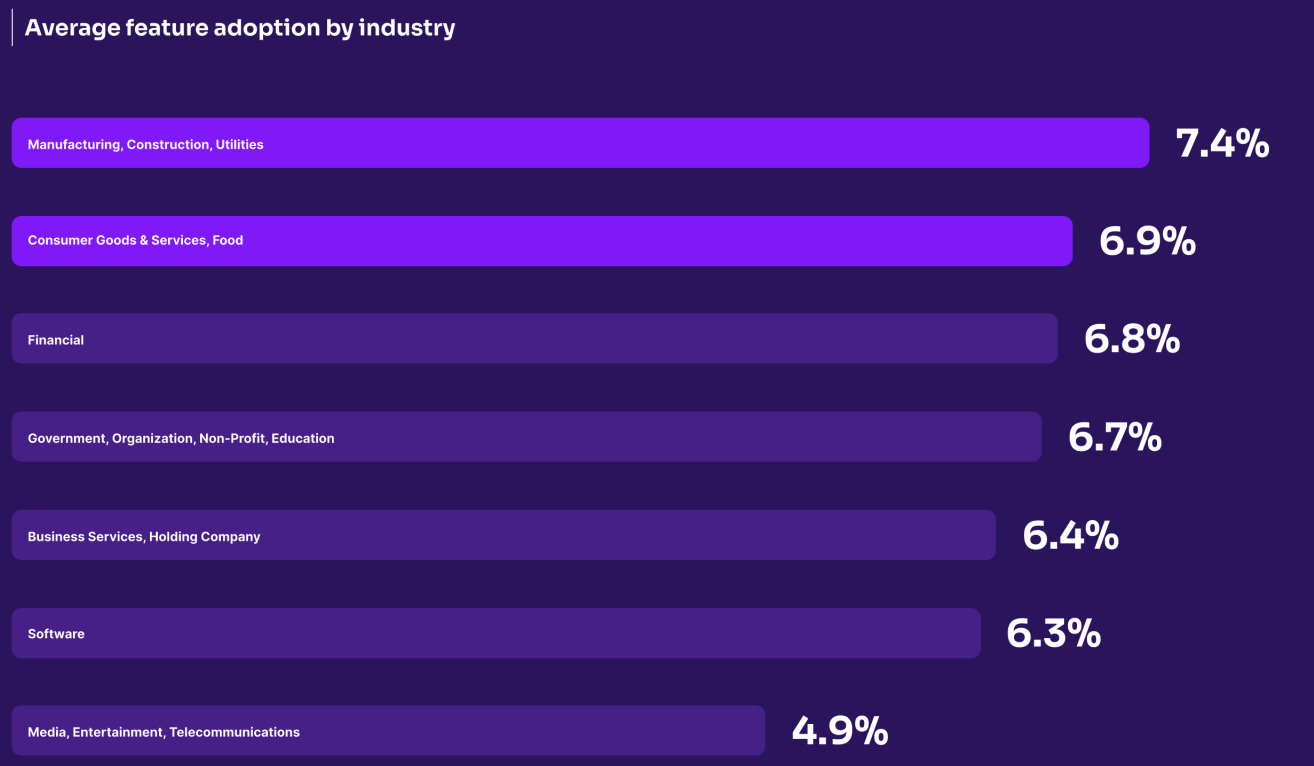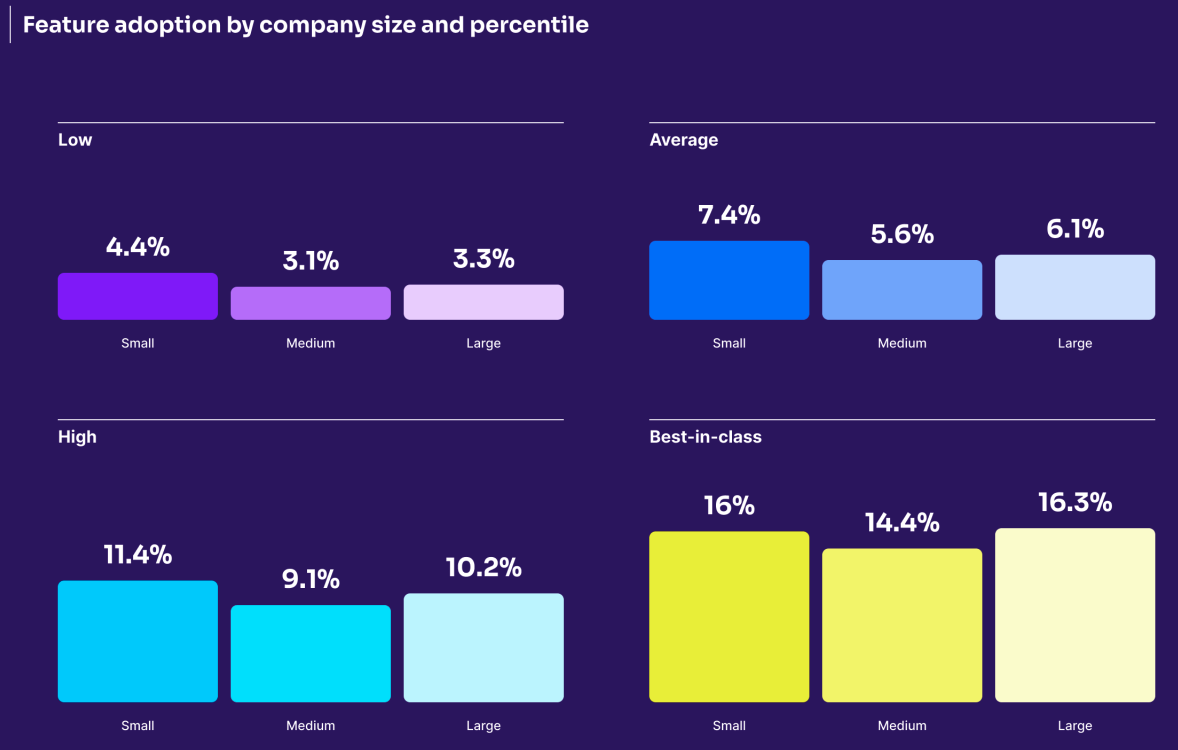Would you stay subscribed to a streaming service each month if you’re only interested in 5% of their shows or movies? With an abundance of streaming services at our fingertips, the answer is: Probably not.
With the move to subscription-based licensing, users don’t just buy digital products once—they buy repeatedly. It’s more important than ever for users to see the value of your product. And the best product managers (PMs) use feature adoption to measure and improve their product’s value.
機能の定着化とは何ですか?
Feature adoption aims to answer one core question: Are users discovering the value of your product and its core tools? By understanding how (or if) customers use specific features, you’ll get a clear view of if those features are achieving their goals.
While feature adoption measures the success and usage of individual features, product adoption measures how many customers start using your product as a whole.
How to measure feature adoption
We measure feature adoption by tracking how many features generate 80% of a user’s click volume. In Pendo, the events that generate 80% of a user’s click volume are also known as Core Events.
How does your product stack up with your peers?
4 types of feature adoption
When measuring feature launches, PMs and customer success managers (CSMs) should consider four types of feature adoption:
- Breadth of adoption: How many users have used the feature?
- Depth of adoption: How often do user roles touch the feature? Are they behaving in unexpected ways?
- Time to adopt: How long does it take for customers to use a new feature?
- Duration of adoption: Does a feature provide value after its introduction? Do they just try it out a few times, or continue to use it?
Why every PM should benchmark feature adoption
- Measure and understand success: Tracking feature adoption reveals if users find your product useful or not. Paired with your Voice of the Customer (VOC) program and product discovery, you can understand the “why” behind lower or higher adoption.
- Know how to improve product engagement: Understanding which features your users actually value—and which they’re ignoring—is foundational to retain and keepusers. Use feature adoption to guide your priorities: What should you improve, and what should you remove within your product?
- Eliminate wasted resources: Poor feature adoption leads to wasted resources, yet many products suffer from feature sprawl. Once you benchmark feature adoption, you can get a better sense of what your users need—and what they don’t.
- Improve your bottom line: Unused features can hurt your bottom line in more ways than one. Paying for unused features lowers a customer’s perceived value and, ultimately, affects their willingness to renew at current price level, or even renew at all.
What’s a “good” feature adoption?
The average, or median, feature adoption rate for products is 6.4%. For every 100 features your team vets, builds, and ships, only 6.4 of them are driving 80% of click volume. For products in the top 10%, feature adoption jumps up to 15.6%—which is 2.5x higher than average.
Even the best product teams are focusing on features that simply don’t matter to their end users. While 6.4% of features are driving 80% of clicks, almost 94% of features are untouched and ignored.
Feature adoption by industry
Upon first glance, industry might not seem important to feature adoption. However, little details like target audience, market saturation, and industry nuances all add up to impact your product benchmarks. A product in Business Services with a 7% adoption rate may be a success. However, 7% feature adoption for a social media app’s new messaging feature might ring some alarm bells.
On average, products in Manufacturing and Consumer Goods have the highest feature adoption rate. Products in Media are slightly lower, at 4.9%.
Depending on your industry’s average feature adoption, you may decide to focus on improving adoption around your most important tools.
Feature adoption by company size
On average, companies with fewer than 200 employees have the highest feature adoption rate at 7.4%.
This may be because smaller companies are in the earlier stages of product expansion, and their Core Events often compose more of their product. On the other hand, larger companies have a sprawling product ecosystem, with more resources to expand and enhance features.
Four ways to improve feature adoption
Launching a new feature and measuring adoption is only beginning. Once you’ve benchmarked this KPI, here are four ways to improve adoption:
- Make adoption simple with walkthroughs: It should be as easy as possible for customers to find and use features. Once you’ve announced a new feature, create in-app walkthroughs to guide users through the desired steps—especially for features that require multiple steps in the workflow.
- Announce new features in-app: One of the best tools to promote features is your product itself. When you announce features in-app via guides or tooltips, you reach users when and where the message is most relevant.
- Make the value and desired action clear: As you create in-app messages or other content about features, use straightforward language that clearly communicates its value. Then, point users to the next action you want them to take (like watching a guided demo).
- Target your communications: Not every feature is relevant to every user. Create segments within your product experience platform by role, permissions, and technical proficiency.
Plot your product’s feature adoption relative to your peers in Mind the Product’s interactive benchmark tool.



![[object Object]](https://cdn.builder.io/api/v1/image/assets%2F6a96e08774184353b3aa88032e406411%2F39f3ccde352b460cbf348ccc952054cd?format=webp)



